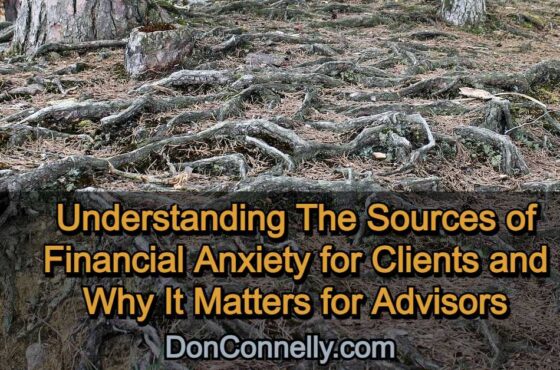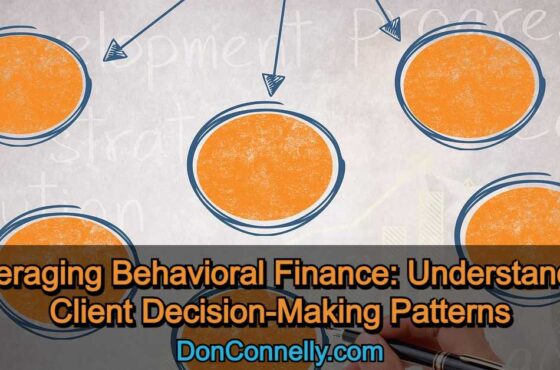Coronavirus: An Opportunity for Financial Advisors to Strengthen Client Relationships
 As I write this after the market close on March 9th, 2020, the Dow Jones Industrial Average is down 1,800 points on the day, for a loss of 7.8%. The S&P 500 is down by 7.6% – the worst single day on for U.S. equities since the 2008 crisis.
As I write this after the market close on March 9th, 2020, the Dow Jones Industrial Average is down 1,800 points on the day, for a loss of 7.8%. The S&P 500 is down by 7.6% – the worst single day on for U.S. equities since the 2008 crisis.
This Monday loss follows some significant volatility late last week that already had a lot of investors on edge.
No doubt, most of you advisors out there are receiving some nervous calls and emails from your clients, wondering what’s going on.
This is where great advisors can earn their money. As a matter of fact, you as financial advisors may well not have as great an opportunity to add value for your clients for a very long time as you do today.
Don’t hide from your clients
First, here’s what not to do:
Don’t hide from the phone and shun your email account. Don’t procrastinate, and don’t be embarrassed that something you recommended to your client had a bad day, a bad week or a bad month.
Instead, grab the bull by the horns. Be proactive, take ownership, and exercise some leadership.
Your clients want and need to hear from you. They want to know that you’ve got a plan. Reach out to them via email, on your Website and blog, and pick up the phone!
Use analogies to help clients understand volatility and how best to react to it.
Seriously, now’s the time to overcommunicate! Bear markets and market corrections are a golden opportunity to differentiate yourself from the robo-advisors and discount brokers.
What to tell your clients about the Coronavirus.
First, don’t say anything promissory. Nobody knows for sure how this will play out in the short-term.
But the vast majority of your clients aren’t short-term investors. They’re long-term investors. And in the long run, we can be reasonably confident that this, too, shall pass.
We’ve been through bigger issues before: The 9/11 attacks. Hurricane Katrina. The Iraq War. The Oil Crisis. The attempted assassination of Ronald Reagan.
As a matter of fact, we’ve even been through other coronavirus outbreaks before. This is actually the seventh coronavirus to affect humans.
It’s also worthwhile to consider how markets responded to previous disease outbreaks. The numbers speak for themselves.
- 1918 – The Spanish Flu. The Spanish flu outbreak was horrific: A worldwide pandemic that killed 20 million worldwide. It killed 500,000 people in the United States. The stock market fell 24.7% that year. Who knows how much of that was due to the Spanish Flu and how much was due to the First World War? But stocks recovered 8.9% in 1919. Then we had the Roaring 20s.
- 1957 – Asian Flu. The Asian flu killed between 1 and 2 million people worldwide. 70,000 of them in the United States. The stock market barely blinked. The S&P 500 rose 24% that same year and rose 2.9% in 1958. Three months after the estimated outbreak in February stocks were up almost 11%.
- 2002 – SARS. We had a market correction coincide with the SARS breakout in 2002. Stocks fell about 6% in the first month after the November outbreak, and were down almost 10% over the trailing three months. This was also around the time the Iraq War was building up. But stocks had fully recovered within 6 months, and were up 15.07% over twelve months trailing the outbreak.
- 2009 – Swine Flu. The Swine flu outbreak came right around the same time stocks were staggering from the effects of the collapse of the mortgage bubble. However, markets didn’t seem to register the Swine Flu at all. Stocks rose almost 10% within a month of the outbreak, were up over 15% in three months, and skyrocketed over 49% over the following year.
- 2013 – Ebola. The Ebola outbreak sparked a major immigration debate here in the U.S. And stocks fell 3.46% in the month following the outbreak in December 2013. But stocks were up 13.68% that year.
- 2016 – Zika. The Zika virus directly affected South Florida a great deal. But markets took this virus in stride: There was an insignificant dip of 0.13% in the first month – inseparable from statistical noise. The S&P was up 13.29% in the next six months, and over 20% in the 12 months following the outbreak in January of 2016.
Calamos Asset Management did a study of all these and other outbreaks, and found that whenever there’s been a similar outbreak sparking a major public health effort in the past, going back over a century to 1918, stocks tend to be back to normal levels in about 3 months, and have actually climbed an average of 9.9 percent over the 12 months following an outbreak.
This is in line with the historic yearly performance of the market, on average.
It’s temporary.
It’s also important to note that none of these outbreaks maintained their morbidity or mortality rates for very long. In each case, these diseases ran their courses, thanks to the terrific efforts of public health officials and the public, as well as the tendency of humans to become more immune to specific strains of viruses over time.
The economic impact of the outbreak isn’t coming from the disease itself. It’s coming from the preventative measures: Airlines cancelling flights, U.S. companies suspending operations in China, people cancelling cruises, meetings and events, and the like. These are only temporary suspensions. There’s going to be some economic disruption, in the short-term, but in the long run these things run their course.
Furthermore, in my opinion, we were long overdue for a market correction. The big traders were itching to take some profits in a strong economy. If it wasn’t the coronavirus, it would have been something else.
Meanwhile, central banks around the world are in a stimulative mode. And the Trump Administration, love ‘em or hate ‘em (it doesn’t matter which!) is also looking at some short-term stimulative measures. Both of which are bullish developments.
Now is the time to remind your clients – your plan isn’t a one-year plan, or even a three-year plan. Your strategy is designed to look good over decades. For the part of the portfolio that’s in stocks, we’d rather have a bumpy 10% than a smooth 6%.
Meanwhile, here’s something else you can tell your clients: Canned tuna is on sale.
So when something you have to buy goes on sale, what do you do? You stock up, right? That’s what your parents did, that’s what your grandparents did… As long as you’ve got the time horizon and risk tolerance, it makes sense for you, too.
As I write this, after the market close on March 9th, 2020, the P/E ratio of the S&P 500 was 20.67. That’s down 7.60% from the day before. That’s the best deal we’ve had in over a year. Before that, you have to go back to 2015 before you could buy stocks this cheaply, relative to earnings.
Tell your clients, our business is weird: It’s the only business where when we have a sale, the public actually freaks out and runs away.
Well, that’s precisely the wrong thing to do!
We’re not day traders. If your clients want a day trader, they probably need a different advisor.
Here’s my message to clients – and it’s the same message, always, all the time, without exception:
- Stick to the basics.
- Don’t try to time the market.
- Have a realistic time horizon.
- Diversify.
Meanwhile, you as advisors should be helping your clients set realistic expectations.
There are going to be setbacks. There are going to be market corrections. The stock market is bumpy. When it gets really bumpy, things go on sale.
Nobody, and I mean nobody, can predict what the stock market will do on any given day, on any given month, or any given year. But we can predict what happens over 20 or 30-year periods with a much better degree of certainty: Stocks tend to track population growth and increases in productivity over long periods of time.
That’s the long-term play, and things still look like they’re on track.
Now go pick up the phone, call your clients and spread the word.
If you are not sure how to calm your clients fears, watch this 3-minute video to learn how our Bear Market Tool Kit will help prepare yourself and expertly guide your clients through bear or volatile markets and win new business during turmoil.
Gain access to the Bear Market Tool Kit today for $149!
5 videos. 3 audios. 9 pdf downloads and links to various resources. All the tools you need to expertly guide prospective and current clients through bear or volatile markets.
If you think your entire team will benefit from a webinar or a conference call on how to guide clients through bear or volatile markets, have your branch manager or home office call 941.346.1166 or email info@donconnelly.com so we can discuss the details and book a date for a webinar or conference call for your firm. Click here for more details on this opportunity.



